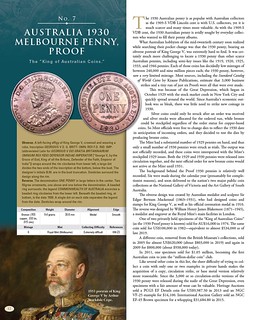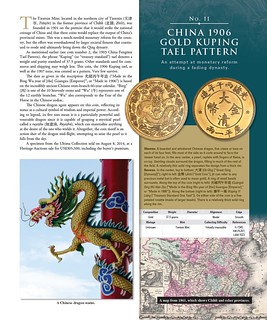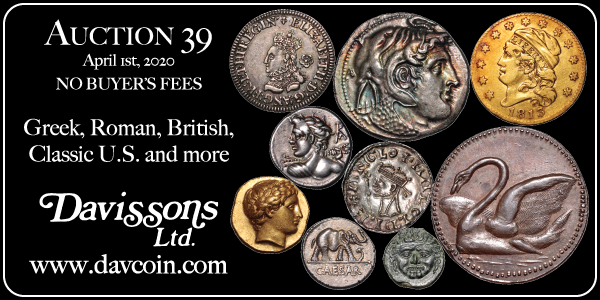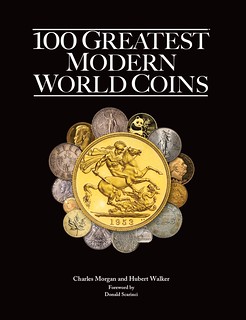
PREV ARTICLE
NEXT ARTICLE
FULL ISSUE
PREV FULL ISSUE
DEFINING "GREATNESS" AMONG MODERN WORLD COINSDennis Tucker of Whitman Publishing passed along this great article by the authors of the upcoming book 100 Greatest Modern World Coins about their criteria for including and ranking the chosen coins. -Editor Defining "Greatness" Among Modern World Coins
In March 2020 Whitman Publishing will release 100 Greatest Modern World Coins, by numismatists Charles Morgan and Hubert Walker. The 168-page coffee-table hardcover will be available from booksellers and hobby shops nationwide, and online (including at www.Whitman.com). Here, the book’s authors address two central questions of their manuscript: What makes a modern coin "great" . . . and why do great coins matter?
In the very first numismatic book in the line, 100 Greatest U.S. Coins, authors Jeff Garrett and Ron Guth outlined six factors: rarity, value, quality, popularity, beauty, and history. Given that Garrett and Guth were writing about a finite set of homogeneous U.S. coin issues, the over-emphasis of any one of these factors (save perhaps beauty) might lead to a rather uninteresting book. Fortunately for all of us, in the first (and each subsequent) edition, this pair of top-tier numismatic researchers found a successful mix that works great for the U.S. coin series. Their books have sparked many lively discussions among the hobby faithful. When it came to developing our own criteria for 100 Greatest Modern World Coins, we had to consider that the sweep of twentieth-century world-coin production was far more complex than an expert survey of the 100 greatest U.S. coin issues, nearly all of which have years of documented price performance and reasonably familiar back stories. Many rare world coins struck in the past 120 years are not well known outside of their issuing countries. Exploring historic auction data for the sale of these coins often requires specialist knowledge and years of market participation. Furthermore, as a collector steeped in American culture, one must be careful not to overemphasize Western aesthetics concerning art produced by other cultures. It’s a delicate dance, to be sure, but one we took a tremendous amount of care to execute as fairly as possible. To us, compiling a list of 100 coins was more a matter of informed compromise. When we set out to make our selections, we started by looking at the coinage output of every country around the globe spanning the past 120 years. We started with the year 1901, not because a valid case couldn’t be made that "modern coinage" started decades, or even a century or more, before, but because we felt the twentieth century was such a consequential period for numismatics that the coins of this century deserved to be considered among their peers. From a numismatic perspective, we consider this period to be an essential area of study to understand the present and future role of coins in society. Over the course of 100 coins, we embarked on an effort to tell that story. To choose the coins on our list, we opted to take into consideration the following criteria. Rarity. Generally speaking, coins are struck to be instruments of commerce that trade freely in exchange for goods and services, and, in order to achieve this goal, should not be rare. But there are instances where coins are struck in very limited numbers. Among our selections, you will find coins struck for kings and queens; coins struck in limited numbers as presentation pieces for important members of government; pattern coins accidentally released into circulation; Proof issues struck in lower numbers than their circulation-strike counterparts; and coins that, for whatever reason, have had most of their mintages lost to time. Rarity is an important factor that affects a coin’s numismatic value, but it is not the sole indicator of it. Innovation. Over the course of the twentieth century, mints around the world introduced a number of important innovations that changed the global landscape of coins. Some of these creations were technical and involved processes and alloys used to strike coins. Some were artistic and introduced bold new aesthetics for coin design that paved the way for a global reimagining of the art form. Other innovations were driven by necessity or the needs of the market, such as long-overdue coinage reforms or the introduction of bullion coins as investment instruments. The twentieth century introduced enormous challenges to the continued utility of coins as a circulating medium. Every step of the way, the world’s coin producers, both big and small, rose to the challenge and secured a viable place for coinage. Coin Sets. Some of the greatest coins of the century need to be viewed in a broader context. Not every entry in our 100 Greatest Modern World Coins is an individual coin. In certain instances we study sets of coins. These sets may include one or more coins that, if considered individually, are sufficiently important to be included on our list. Other entries are known to collectors primarily as sets and it would be inconceivable to talk about one coin without discussing the others. Our goal was to valorize as many of the highlights of twentieth-century world coinage as possible, and in doing this we’ve included a fair number of sets. Oddities and Emergency Issues. Human beings are amazing and resilient, and some of the most fascinating numismatic stories to unfold in the twentieth century center around coins that are a little off the beaten path. Some are limited-run vanity issues projecting the power and prestige of failed kings and despots, issued on the cusp of their overthrow, while others are crudely made pieces of emergency money issued by revolutionaries or by desperate people whose "revolutionary" idea was to survive no matter the cost. If holding a coin is like holding history in your hands, then coins struck in these ironic, unusual, and desperate circumstances tell us something about human nature and have an intrinsic greatness that is hard to ignore. Auction Data and Market Values. This book presented an interesting challenge: How does one weigh an entire range of factors relating to modern world-coin issues and organize the coins so that the broadest survey is possible and auction data, certified-coin populations, and collector popularity aren’t overemphasized? We made every effort to review a variety of auction sources, historical records, and market-maker insights about the coins presented in 100 Greatest Modern World Coins. But we know that not every auction for every world coin included (or excluded) has been taken into consideration. We provide certain auction data and market values for general interest, but we do not want readers to get the mistaken impression that every modern world coin that has ever sold for a significant sum of money was automatically included in our selection. Conversely, some of the coins on our list are readily available to collectors and hardly considered rare at all. If you use 100 Greatest Modern Coins to make purchasing decisions about rare and valuable coins, know that our ranking system is an opinion and should not outweigh your due diligence and appreciation of a piece. Lists are conversation starters and not the final word. The beauty of this is that the numismatic hobby is forever evolving and there is no shortage of stories to tell.   Why Do Great Coins Matter? Many of the entries in 100 Greatest Modern World Coins fall outside the financial means of most collectors, and some pieces are so rare that the only known examples are held in museums or institutional collections. Others are so seldom encountered that it may take generations for an example to come to market. That’s okay. More important than owning one of the world’s greatest coins is the enrichment that comes from knowing its story and relating this information to the pursuit of other coins of its type, of the period, or of its issuing country. The rarest of the rare coins that we consider the greatest are truly landmarks on the numismatic skyline. Other great coins might be expensive but approachable, or not very expensive at all. A few of the coins on our list may be available for a small premium over current market value—or even a small premium over face value. Regardless of cost or even the public’s general perception of them, these greatest world coins have an important story to tell . . . but then, so do great coins, so do good coins, and so do average coins. No matter the scope or scale of your collection, the coins you select have stories. Every coin ever struck plays some role in making coin collecting a dynamic hobby. It is our hope that in reading our book, 100 Greatest Modern World Coins, you find yourself inspired to discover these stories and propel forward our hobby community’s appreciation for coins both great and ordinary. 100 Greatest Modern World Coins
About the Authors
His main areas of collecting interest are numismatic literature and the coins and medals of the Food and Agriculture Organization (FAO) of the United Nations. He also collects U.S. coins, classic films, and comic books. Morgan studied English at Susquehanna University and the University of Virginia and served in the U.S. Army as a Russian linguist. He lives in Virginia with his wife, two children, and a very temperamental Maine Coon cat. Hubert Walker is the assistant editor of CoinWeek.com and along with Charles has written numerous award-winning articles and columns, both online and in print. He studied English at the University of Virginia, though he is also keen on history, music, and art. Hubert currently resides in Virginia; his cat does not. To read the earlier E-Sylum articles, see:
 Wayne Homren, Editor The Numismatic Bibliomania Society is a non-profit organization promoting numismatic literature. See our web site at coinbooks.org. To submit items for publication in The E-Sylum, write to the Editor at this address: whomren@gmail.com To subscribe go to: https://my.binhost.com/lists/listinfo/esylum All Rights Reserved. NBS Home Page Contact the NBS webmaster 
|
